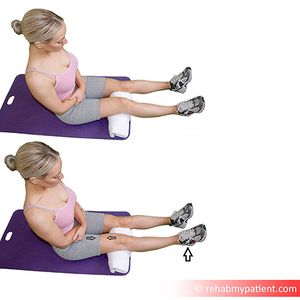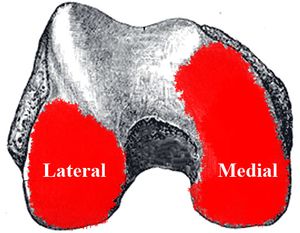Screw Home Mechanism of The Knee Joint
Definition[edit | edit source]
Screw home mechanism (SHM) of knee joint is a critical mechanism that play an important role in terminal extension of the knee.
- There is an observable rotation of the knee during flexion and extension.
- During the last 30 degrees of knee extension, the tibia (open chain) or femur (closed chain) must externally or internally rotate, respectively, about 10 degrees.
This rotation is important for healthy movement of the knee.[1][2][3][4][5][6].
- This slight rotation in the last 15 degrees of knee extension is due to inequality of the articular surface of femur condyles.
- Tibial-on-femoral rotation occurs in an open chain exercise like in the leg extension machine, tibia externally rotates.
- Femoral-on-tibial rotation, as in a closed chain exercise like the squat, femur internally rotates
- Rotation must occur to achieve full extension and then flexion from full extension.
Also you can check anatomy of knee section in Physiopedia.
Physiological/Mechanical Movement Patern[edit | edit source]
Mechanical Paradox: Articular surface of medial condyle of femur is greater than the articular surface of later condyle.
Physiological Movement: Both medial and lateral condyle moves on articular surface of tibia (medial/lateral meniscus)
Kinetic Chain: Open kinetic chain (foot and calf freely moves)
Movement: Terminal extension of the knee
Screw Home Movement: During extension when all articular surface of lateral condyle is used by roll movement there are still unused articular surface on medial condyle. Femur glides posteriorly on tibia to use full articular surface of medial condyle. Then knee is locked by vastus medialis obliquus.
Clinical Manifestations of Screw Home Mechanism[edit | edit source]
Terminal Knee Extention Exercise[edit | edit source]
Terminal knee extention is a specific exercise for vastus medialis obliquus muscle. In earlier descriptions of the exercise it is sugested to improve muscle force of vastus medialis obliquus. Further descriptions also focused on motor leraning and vastus medialis obliquus time delay during terminal extention.

Clinical Relevelance[edit | edit source]
In most of the knee problems generally there is an insufficiency on terminal extension and vastus medialis obliquus function. Restoration of terminal extension is an important goal of rehabilitation program. Terminal extension exercises like interventions have important contribution on restoration of screw home movement /terminal extension.
References[edit | edit source]
- ↑ Goodfellow J, O'Connor J. The mechanics of the knee and prosthesis design. J Bone Joint Surg Br. 1978;60(3):358–369.
- ↑ Bytyqi D, Shabani B, Lustig S, Cheze L, Karahoda Gjurgjeala N, Neyret P. Gait knee kinematic alterations in medial osteoarthritis: three dimensional assessment. Int Orthop. 2014;38(6):1191–1198.
- ↑ Ishii Y, Terajima K, Terashima S, Koga Y. Three-dimensional kinematics of the human knee with intracortical pin fixation. Clin Orthop Relat Res. 1997;(343):144–150.
- ↑ https://www.ncbi.nlm.nih.gov/pubmed/12135550
- ↑ Asano T, Akagi M, Tanaka K, Tamura J, Nakamura T. In vivo three-dimensional knee kinematics using a biplanar imagematching technique. Clin Orthop Relat Res. 2001;(388):157–166
- ↑ Kim, H. Y., Kim, K. J., Yang, D. S., Jeung, S. W., Choi, H. G., & Choy, W. S. (2015). Screw-Home Movement of the Tibiofemoral Joint during Normal Gait: Three-Dimensional Analysis. Clinics in orthopedic surgery, 7(3), 303–309. doi:10.4055/cios.2015.7.3.303







